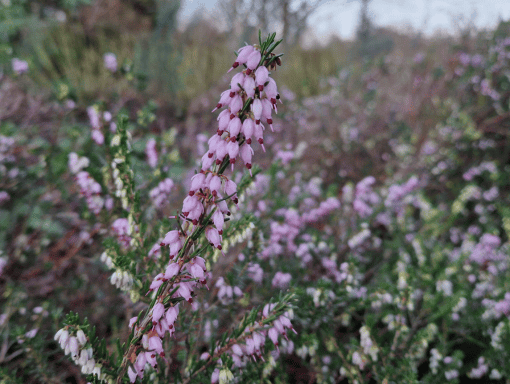Head of Horticulture blog: February 2025
February is a month of transition in the UK garden—caught between the lingering grip of winter and the first whispers of spring. But this year, the relentless storms, howling winds, and driving rain may be making it feel more like a battle zone than a place of peace.
While the weather may not always be inviting, there’s still plenty you can do to prepare your garden for the growing season ahead. So, don your waterproofs, brace yourself against the gales, and let’s dive into this month’s essential gardening tasks.
Plan ahead for spring
With stormy weather keeping many of us indoors, February is the perfect time to plan for the months ahead. Curl up with a cup of tea and browse seed catalogues, dreaming up vibrant flower beds and bountiful vegetable patches. Consider crop rotation to maintain soil health, and sketch out your garden design, taking note of any wind damage that may need repairing.
Now is also a good time to check your gardening tools—clean, sharpen, and oil them so they’re ready for action when the weather improves. A well-maintained toolkit will make the transition into spring much smoother.
Prune trees, shrubs and roses
Despite the storms, February remains one of the best times to prune deciduous trees and shrubs while they are still dormant. Strong winds may have broken or damaged branches, so carefully remove these to prevent disease and encourage healthy regrowth. Be mindful of trees and shrubs that flower on last year’s wood, such as forsythia—pruning too early may mean fewer blooms come spring.
If you have wisteria, now is the time for its second pruning. Cut it back to two or three buds per spur to encourage an explosion of flowers. Roses, too, need attention—prune hybrid teas and floribundas by cutting back stems to an outward-facing bud, creating a tidy and strong framework for new growth.
Tidy up the garden
After weeks of storms, your garden may be littered with fallen branches, leaves, and wind-blown debris. Take advantage of calmer days to clear up, ensuring pests and diseases don’t take hold in damp, decaying matter.
Trim back ornamental grasses and perennials that have been left for winter interest, but be careful not to disturb new shoots pushing through the soil. Compost any healthy plant material, but discard anything showing signs of disease to prevent spreading issues later in the season.
Prepare the soil
Heavy rain can leave soil waterlogged, making it difficult to work with. If the ground is too wet, avoid walking on it to prevent compaction—lay down boards to spread your weight if necessary.
On drier days, dig over empty vegetable beds to expose overwintering pests to the cold. Work in organic matter such as well-rotted manure or compost to enrich the soil, ready for spring planting. If drainage is an issue, consider raised beds or installing drainage solutions to help plants thrive in wetter conditions.
Start sowing seeds indoors
With the weather still unpredictable, February is the perfect time to start seeds indoors. Tomatoes, chillies, and peppers benefit from an early start in a heated propagator or on a sunny windowsill.
Other good candidates for indoor sowing include sweet peas, leeks, and herbs like basil and parsley. Use seed trays or pots filled with fine compost, and keep the soil moist but not waterlogged.

Pale lilac winter heather starting to bloom

Acer reflected in the pond on a winter day
Plant bare-root trees and shrubs
As long as the ground isn’t frozen or saturated, February is an excellent time to plant bare-root trees, shrubs, and hedging plants. Soak the roots for an hour before planting, then dig a hole large enough to accommodate them comfortably. Firm the soil around them and water well to help establish strong root systems.
Protect plants from frost and storm damage
With winter’s unpredictability, frost and storms can arrive without warning. Protect vulnerable plants with fleece, cloches, or horticultural fabric, and check greenhouse heaters are working properly. If high winds are forecast, secure any loose structures, such as trellises and plant supports, to prevent damage.
Move tender plants in pots to more sheltered areas or into greenhouses. For large containers that cannot be moved, wrap them in bubble wrap or hessian to insulate the roots.
Care for wildlife
February can be tough for wildlife, especially after relentless rain and cold spells. Keep bird feeders well stocked with seeds and suet, and ensure fresh water is available—breaking any ice that forms on birdbaths.
Avoid cutting back hedges too drastically, as they provide vital shelter for birds and small mammals. Leaving some areas undisturbed will also benefit insects, which in turn support the garden ecosystem.
Force rhubarb
If you grow rhubarb, now is the time to start forcing it for an earlier, sweeter harvest. Cover the crown with an upturned bucket, pot, or special forcing cloche to block out light, encouraging tender stems to develop. Forced rhubarb will be ready to harvest in about eight weeks.
Check overwintering plants
If you’ve been overwintering tender plants in greenhouses or cold frames, now is the time for a health check. Look out for pests such as aphids or red spider mites, remove dead foliage, and ensure good ventilation to prevent mould. Water sparingly, as most overwintering plants are still in dormancy and won’t need much moisture.
Divide snowdrops
As snowdrops finish flowering, lift and divide congested clumps to encourage better displays next year. Replant immediately at the same depth in moist, well-drained soil.
Order summer bulbs
With dreams of brighter days ahead, now is the time to order summer-flowering bulbs such as lilies, gladioli, and dahlias. Plant them in spring for a vibrant display when the warmer months arrive.
Final thoughts
February may be a month of wind-whipped gardens, sodden soil, and sudden frosts, but don’t let the stormy weather dampen your enthusiasm. Every small effort now—whether pruning, planning, or preparing—will help your garden burst into life when spring finally takes centre stage. So, embrace the elements, and know that brighter days and flourishing gardens are just around the corner.
Spring has sprung at Furzey Gardens
All around the garden there are signs that the garden is waking up from its winter slumber. Snowdrops, crocus and daffodil are all starting to appear, whilst the buds on trees and shrubs are beginning to swell, full of promise for beautiful sights in the weeks and months to come.
Over the winter the gardening team have been clearing some of our more overgrown areas, opening up new vistas that highlight some of Furzey Gardens striking thatched structures. Whilst carrying out the work around Typhoon Tower the team made an exciting discovery when they found one of our lesser known fairy doors – Camellia Cottage, a joyful find amongst all the hard work.
A special project that our supported gardeners are focusing on this year is to transform the paddock into a thriving fruit orchard. The Picking Patch will be a serene and beautiful space where the gardeners can grow in confidence, hone their craft, and take pride in their achievements. Thanks to generous donations from our supporters this project is gathering pace as the team work hard to make this space a haven for themselves and for wildlife. Find out more about how you can support The Picking Patch.
What's on this half term at Furzey Gardens
Join us this half term to help wake the gardens from their winter slumber with our ‘Wonderful Wands’ workshop!
Children can create their own wand in our volunteer-led workshop before following the trail around the gardens to bring sleeping blooms to life, welcome back wildlife, and uncover the garden’s hidden secrets. With each wave of their wand, they’ll spark the magic of spring as they explore.
Dates: 15–23 February
Cost: £3 per child (plus standard garden entry)
Suitable for: Ages 3–11
No pre-booking required
Find out more about our Wonderful Wands activity and trail.
This article originally appeared as the monthly In The Garden column in the Lymington Times, buy the paper on the second Friday of every month to read the next column first.
